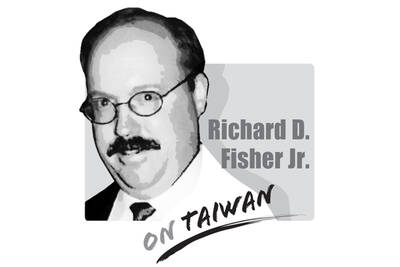If a tree falls in a forest and no one is around to hear it, yes, it does make a sound. By the same token, a secret deal struck between two parties without other parties or the public being informed can have a very real impact. And if a memorandum of understanding (MOU) is signed between Beijing and the WHO without Taiwan being consulted, it very clearly exists.
President Ma Ying-jeou’s (馬英九) statement on Monday to the contrary was, to put it bluntly, dumbfounding.
China’s “secret” MOU with the WHO is hardly secret — and both the Ministry of Foreign Affairs and the Department of Health have no problem acknowledging the existence of this document, which reportedly stipulates that communication between the WHO and Taiwan can only take place with Beijing’s consent.
After Presidential Office Spokesman Wang Yu-chi (王郁琦) said earlier this month that the Presidential Office was unsure whether the MOU existed, Ma made similar remarks on Monday, questioning the former Democratic Progressive Party (DPP) administration’s claim that an MOU was signed.
“We are uncertain whether China signed an MOU with the WHO ... but because [the Chinese Nationalist Party (KMT)] was not in power at the time, we have no way of finding out,” Ma said in an interview with Taiwan’s China Television.
In light of past statements by officials in his administration, including Department of Health Minister Yeh Ching-chuan (葉金川) and Deputy Minister of Foreign Affairs Andrew Hsia (夏立言), Ma was setting himself up for trouble. Given their open and unambiguous discussion of the MOU, the president must have had a clear motive for an about-face that could only make him look disingenuous.
It seems unlikely that Ma or any other top figure in the KMT would doubt the MOU’s existence. In 2005, then-director of the KMT’s Mainland Affairs Department Chang Jung-kung (張榮恭) was quoted by several media outlets, including the Central News Agency, as saying that he had been informed of the MOU’s contents by Taiwan-related agencies in China. The MOU took effect on May 14, 2005, Chang told the media.
But the evidence doesn’t stop there. Although the MOU has never formally been made public, WHO Director-General Margaret Chan (陳馮富珍) mentioned the document in an interview with China’s state-run Xinhua news agency.
“On Taiwan’s participation in the WHO’s technical activities, Chan said the WHO would deal with the issue in accordance with a Memorandum of Understanding (MoU) signed with China,” Xinhua reported on Nov. 27, 2006. “The MoU on Taiwan health and medical experts’ participation in WHO technical activities was signed between the Chinese Ministry of Health and the WHO Secretariat in 2005.”
“Facts show that the memorandum has played a positive role,” said Chan, then newly elected as the world health body’s director-general.
No one, it would seem, is denying the existence of the MOU except the Presidential Office. The goal, it seems, is to convince the public that Taiwan’s admittance to the World Health Assembly as an observer this year was not achieved through Beijing, as would be required by the MOU.
But traces of the MOU are everywhere. The question is what the president stands to gain from squandering his credibility.

On Sept. 3 in Tiananmen Square, the Chinese Communist Party (CCP) and the People’s Liberation Army (PLA) rolled out a parade of new weapons in PLA service that threaten Taiwan — some of that Taiwan is addressing with added and new military investments and some of which it cannot, having to rely on the initiative of allies like the United States. The CCP’s goal of replacing US leadership on the global stage was advanced by the military parade, but also by China hosting in Tianjin an August 31-Sept. 1 summit of the Shanghai Cooperation Organization (SCO), which since 2001 has specialized
In an article published by the Harvard Kennedy School, renowned historian of modern China Rana Mitter used a structured question-and-answer format to deepen the understanding of the relationship between Taiwan and China. Mitter highlights the differences between the repressive and authoritarian People’s Republic of China and the vibrant democracy that exists in Taiwan, saying that Taiwan and China “have had an interconnected relationship that has been both close and contentious at times.” However, his description of the history — before and after 1945 — contains significant flaws. First, he writes that “Taiwan was always broadly regarded by the imperial dynasties of
A large part of the discourse about Taiwan as a sovereign, independent nation has centered on conventions of international law and international agreements between outside powers — such as between the US, UK, Russia, the Republic of China (ROC) and Japan at the end of World War II, and between the US and the People’s Republic of China (PRC) since recognition of the PRC as the sole representative of China at the UN. Internationally, the narrative on the PRC and Taiwan has changed considerably since the days of the first term of former president Chen Shui-bian (陳水扁) of the Democratic
A report by the US-based Jamestown Foundation on Tuesday last week warned that China is operating illegal oil drilling inside Taiwan’s exclusive economic zone (EEZ) off the Taiwan-controlled Pratas Island (Dongsha, 東沙群島), marking a sharp escalation in Beijing’s “gray zone” tactics. The report said that, starting in July, state-owned China National Offshore Oil Corp installed 12 permanent or semi-permanent oil rig structures and dozens of associated ships deep inside Taiwan’s EEZ about 48km from the restricted waters of Pratas Island in the northeast of the South China Sea, islands that are home to a Taiwanese garrison. The rigs not only typify